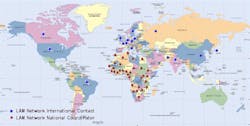
The International Year of Light and Light-based Technologies (IYL 2015) is a year-long series of activities across the world, all designed to publicize and promote photonics, as well as to facilitate networking and organizing of individuals and organizations in photonics. One goal of IYL 2015 of particular interest to me is the "special aim to create, as a legacy of 2015, a sustainable African Optics and Photonics Society" (quotes and much of the information below are taken from this page of the IYL 2015 website).
The African continent is home to a rapidly growing photonics market. As Yanne Chembo, a researcher at the Centre National de la Recherche Scientifique (CNRS) Paris and the African Physical Society (and who is himself from Cameroon), noted in a talk at the Laser World of Photonics 2015 (Munich, Germany) as well as in a presentation at UNESCO's opening of ILY 2015, 10% to 20% of African countries' budgets are devoted to telecommunications; Africa is the world's second-largest mobile-phone market; and Africa produces 300 MW of solar energy now. Chembo states that, as for training in photonics technology in Africa (such as for medical, industrial, agriculture applications), "this has to be the year."
The Africa-related aims and goals of ILY 2015 include:
--creating greater awareness of the potential of light-based technologies for solving many of the challenges facing the African continent;
--expanding interaction between academics, industries, and professionals in using optics and photonics concepts in tapping developmental strategies for communities, with the view to enable policy makers to appreciate the relevance of science for economic advancement; and
--attracting young innovators to the study and application of light-based technologies for the benefit of the continent.
Expected outcomes include:
--expansion of educational opportunities in optical sciences and technology for capacity and industrial building;
--establishment of subregional centers of excellence in light-based technologies for the promotion of optics and photonics;
--expansion of research infrastructure to uphold new consciousness in optics and photonics for the emerging economies towards nation-building; and
--increase in the number of young innovators in optics and photonics, particularly, in the areas of medicine, communication, agriculture, and energy applications relevant to the various national needs.
| Formed in 1991, the African Laser, Atomic, Molecular, and Optical Sciences (LAM) Network has contacts around the world. (Image: LAM Network) |
Resources include the numerous photonics and other technical organizations based in Africa, such as:
--the African Laser, Atomic, Molecular, and Optical Sciences (LAM) Network (Dakar, Senegal), an organization with more than 20 participating African countries;
--the Council for Scientific and Industrial Research (CSIR) (Pretoria, South Africa);
--the African Network for Solar Energy (ANSOLE); and
--the Tunisian Optical Society, which is sponsored by SPIE and OSA.
This effort by IYL 2015 and the various African technical organizations to boost photonics training and research in Africa, and thus further increase the integration of photonics into the African economy, will benefit both the growing African middle class (now 300 million people, according to Chembo) and the very large number of Africans who as yet have no access to electricity and who can also benefit from innovations in health, agriculture, and industry brought about by photonics.
About the Author
John Wallace
Senior Technical Editor (1998-2022)
John Wallace was with Laser Focus World for nearly 25 years, retiring in late June 2022. He obtained a bachelor's degree in mechanical engineering and physics at Rutgers University and a master's in optical engineering at the University of Rochester. Before becoming an editor, John worked as an engineer at RCA, Exxon, Eastman Kodak, and GCA Corporation.

